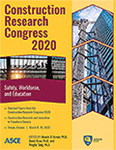Construction Research Congress 2020
Improving Safety Performance in Construction Using Eye-Tracking, Visual Data Analytics, and Virtual Reality
Publication: Construction Research Congress 2020: Safety, Workforce, and Education
ABSTRACT
Globally, construction is among the most dangerous industries. Among others, research has demonstrated that construction workers and professionals fail to recognize and manage an unacceptable number of safety hazards. To address this, past research has focused on examining several factors including training, education, and management support that may indirectly influence hazard identification and management performance. However, proximal factors associated with poor hazard identification and management at the work interface has received very little attention. This paper summarizes our research aimed at (1) understanding why workers fail to identify and manage safety hazards as they participate in hazard recognition and management efforts and; (2) developing evidence-based interventions to counter poor hazard identification and management performance in the construction industry. This includes examining hazard recognition as a visual search task and understanding how search pattern (i.e., how workers examine the work environment) affects hazard recognition performance. More specifically, the research used eye-tracking technology to examine the relationship between how workers examine the workplace and the resulting hazard identification performance. Based on this new knowledge generated, new interventions were developed to improve hazard recognition and management performance. These include two interventions. First, an immersive hyper-realistic mixed reality training environment that was developed using stereoscopic visual data captured from real construction workplaces. The testing of the intervention with 56 participants suggested that the intervention can significantly improve hazard identification and management performance. Second, an AI-based system that detects hazardous conditions and objects in real-time to assist workers and managers. The system uses the live video captured by a wearable camera to localize the workers on a pre-built global map, detect any hazard present around the worker, and warns them in real-time. The system is tested in indoor and outdoor construction environments, which indicate 93% accuracy in detecting workers’ proximity to hazards.
Get full access to this article
View all available purchase options and get full access to this chapter.
REFERENCES
Ahmed, S. M., Azhar, S., and Forbes, L. H. (2006). “Costs of injuries/illnesses and fatalities in construction and their impact on the construction economy.” Proc., Int. Conf. on Global Unity for Safety and Health in Construction, 363–371.
Albert, A., Hallowell, M. R., and Kleiner, B. M. (2014). “Enhancing Construction Hazard Recognition and Communication with Energy-Based Cognitive Mnemonics and Safety Meeting Maturity Model: Multiple Baseline Study.” Journal of Construction Engineering and Management, 140(2), 04013042.
Bahn, S. (2013). “Workplace hazard identification and management: The case of an underground mining operation.” Safety Science, 57.
Biggs, A. T., and Mitroff, S. R. (2015). “Improving the efficacy of security screening tasks: A review of visual search challenges and ways to mitigate their adverse effects.” Applied Cognitive Psychology, Wiley Online Library, 29(1), 142–148.
BLS. (2018). “OSHA: Commonly Used Statistics.” Osha.gov, https://stats.bls.gov/iif/oshcdnew.htm> (May 11, 2019).
Carter, G., and Smith, S. D. (2006). “Safety Hazard Identification on Construction Projects.” Journal of Construction Engineering & Management, 132(2), 197–205.
Graham, D. J., and Jeffery, R. W. (2011). “Location, location, location: eye-tracking evidence that consumers preferentially view prominently positioned nutrition information.” Journal of the American Dietetic Association, Elsevier, 111(11), 1704–1711.
Jaselskis, E. J., Anderson, S. D., and Russell, J. S. (2002). “Strategies for Achieving Excellence in Construction Safety Performance.” Journal of Construction Engineering and Management.
Jeelani, I., Albert, A., and Gambatese, J. A. (2017). “Why Do Construction Hazards Remain Unrecognized at the Work Interface?” Journal of Construction Engineering and Management, 143(5).
Lingard, H. (2013). “Occupational health and safety in the construction industry.” Construction Management and Economics, 31(6), 505–514.
Nodine, C. F., and Kundel, H. L. (1987). “Using eye movements to study visual search and to improve tumor detection.” Radiographics, 7(6), 1241–1250.
ROS. (2018). “Robot Operating System.” ROS.
Schwatka, N. V, and Rosecrance, J. C. (2016). “Safety climate and safety behaviors in the construction industry: The importance of co-workers commitment to safety.” Work, IOS Press, 54(2), 401–413.
Sharafi, Z., Shaffer, T., Sharif, B., and Gueheneuc, Y.-G. (2015). “Eye-Tracking Metrics in Software Engineering.” 2015 Asia-Pacific Software Engineering Conference (APSEC), 96–103.
Information & Authors
Information
Published In
Construction Research Congress 2020: Safety, Workforce, and Education
Pages: 395 - 404
Editors: Mounir El Asmar, Ph.D., Arizona State University, David Grau, Ph.D., Arizona State University, and Pingbo Tang, Ph.D., Arizona State University
ISBN (Online): 978-0-7844-8287-2
Copyright
© 2020 American Society of Civil Engineers.
History
Published online: Nov 9, 2020
Published in print: Nov 9, 2020
Authors
Metrics & Citations
Metrics
Citations
Download citation
If you have the appropriate software installed, you can download article citation data to the citation manager of your choice. Simply select your manager software from the list below and click Download.
